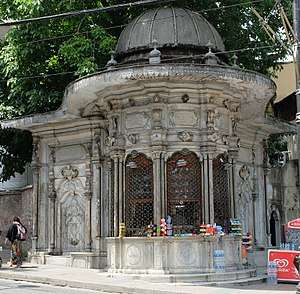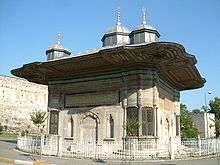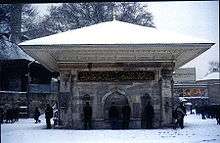Sebil (fountain)

A sebil or sabil (Arabic: سبيل; Turkish: sebil) is a small kiosk where water is freely dispensed to members of the public. Historically, it is a structure of both civic and religious importance in Muslim cities, most characteristically under the Ottoman Empire[1][2], but also in other regions and periods such as Mamluk Cairo[3]. It is sometimes also used to refer to simple fountains for drinking water.[4] Sebils were built at crossroads, in the middle of city squares, and on the outside of mosques and other religious complexes throughout the Ottoman Empire to provide drinking water for travelers and enable ritual purification (ablutions) before prayer.
Description and function
A typical sebil was built over an underground cistern which supplied the water for distribution.[5] In some cases, the pumped water ran down a decorative carved marble panel called a selsebil, which may also have served the purpose of aerating the water as it came from the cistern.[5] This service was free to members of the public, and was paid for by the revenues or funds of a charitable endowment, an Islamic waqf, provided or set up by the patron who commissioned the building.[5][1][3] Endowing money for the construction of sebils was considered an act of piety, and the construction of many sebils was considered the hallmark of a beneficent ruler.[6]
- Example of a sebil: The street facade of the Sabil of Tusun Pasha (or Sabil of Muhammad Ali), Cairo.
- Water dispensing area inside the sebil.
 The underground water cistern for the sebil.
The underground water cistern for the sebil.
History
In 16th century Istanbul, sebils were a symbol of public possession. The attempt to add spigots was opposed because this was perceived as limiting public access to the blessings of nature. Initially, they functioned as kiosks where water was distributed to passersby.[7] Often they were decorated in the Ottoman Rococo style and inscribed with Ottoman Turkish verses that formed a chronogram using the Abjad numbers to date the construction. Until the spread of inhouse plumbing by the end of the 20th century, they were essential for the daily life of the inhabitants of Istanbul.
Gallery


.jpg)

 Sebil outside Rachel's Tomb
Sebil outside Rachel's Tomb
_in_Lod.jpg)
 Sebil in Tel Aviv
Sebil in Tel Aviv
 Sebil of Ali Bey Al-Kabir in Tanta, Egypt
Sebil of Ali Bey Al-Kabir in Tanta, Egypt
See also
References
- 1 2 Kuban, Doğan (2010). Ottoman Architecture. Woodbridge, Suffolk, UK: Antique Collectors' Club. ISBN 9781851496044.
- ↑ Sumner-Boyd, Hilary; Freely, John (2010). Strolling Through Istanbul: The Classic Guide to the City. New York: Tauris Parke Paperbacks. ISBN 9781848851542.
- 1 2 Behrens-Abouseif, Doris (2007). Cairo of the Mamluks : A History of Architecture and Its Culture. Cairo: The American University in Cairo Press. ISBN 9789774160776.
- ↑ Petersen, Andrew (1996). Dictionary of Islamic Architecture. New York: Routledge. p. 254. ISBN 0415213320.
- 1 2 3 Williams, Caroline (2008). Islamic Monuments in Cairo: The Practical Guide (6th edition). Cairo: American University in Cairo Press. p. 63. ISBN 9789774162053.
- ↑ Ottoman sabils of Jerusalem Archived 2015-04-24 at the Wayback Machine.
- ↑ A public meeting point: Sebil of Nuruosmaniye
External links
| Wikimedia Commons has media related to Sebils. |
- Sebil in the dictionary of Islamic architecture
- Fountains of Istanbul
-Jerusalem-Temple_Mount-Dome_of_the_Rock_(SE_exposure).jpg)